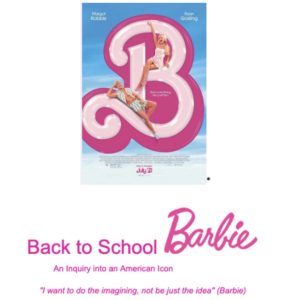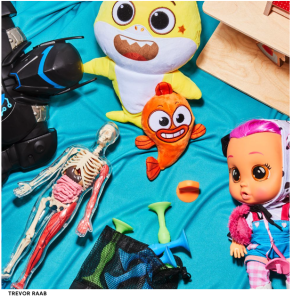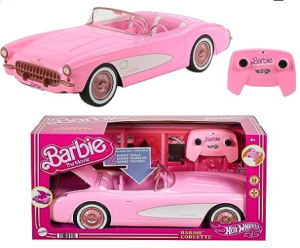Back to School Barbie: An Inquiry into an American Icon
An Inquiry into an American Icon* by Carol Arcus, Neil Andersen, and Michelle Solomon
“I want to do the imagining, not be just the idea” (Barbie)
The 2023/2024 school year has begun and Barbie, the summer blockbuster film by Greta Gerwig, has captured the collective imagination. The Barbie doll has been a part of our lives since 1965, so why the big fuss in Summer, 2023? Why a movie? Why has the movie earned more than a billion dollars? Why has it received so much attention? Why are some viewers ecstatic and others angered? What might its sequel look like?
Barbie the doll, the movie, the news reports and social media posts, the Dream Houses, cars, boats and more are all media experiences, so as media educators, we thought it might be fun to imagine how to use Barbie in the classroom as a case study of a summer movie. Barbie has delighted and divided her audience (likely in equal measure), and the movie plays with those (and many more) binary oppositions. As Gerwig has said in a New York Times article, “The story of Barbie is the fight that’s been going on about Barbie.” What are our stories about Barbie? What are our students’ stories about Barbie? Asking these types of questions can be a catalyst for inquiry projects—across the curriculum. Together they provide teachers of all students wonderful opportunities to explore their relationships to media and popular culture. These relationships implicate media studies, but also art, music, history, social studies, business studies, health & phys-ed, language and literature. Bringing fun and playfulness into the classroom is a great way to integrate media literacy!
Please join us as we explore the meanings, pleasures and challenges Barbie has provided. These lesson ideas lend themselves particularly well to a flexible, collaborative inquiry classroom. Teachers are invited to tailor the scope and nature of the questions and activities to their curriculum and class needs. Activities may be used as a springboard for more exploration, including integration with other subject areas.
The AML uses two frameworks to power students’ explorations of media experiences. One is The Eight Key Concepts of Media Literacy and the other is The Media Literacy Triangle. Each of these frameworks provides students with a method to investigate, understand and appreciate media experiences. Click on the links above to learn more about these frameworks.
*You can find the Resource below, or click here for a handy pdf version.
*
PRIMARY/JUNIOR
www.telegraph.co.uk
COLOUR:
Ontario Curriculum connections include: The Arts; Health and PhysEd; Language (Digital/Media Literacy)
Visual media (paintings, photographs, videos) use colour purposefully to communicate meanings. Paying attention to colours increases students’ understanding and enjoyment.
Pink is a commonly-used colour in BarbieLand. It appears in buildings, costumes and props.
Why do you think pink is used so much?
Might the historic use of pink in girls’ toy designs have created a bias in people’s minds? I.e., might people have learned to associate pink with girls so much that boys wearing pink seems unnatural?
When the Kens seize power in BarbieLand they move into the Barbie’s houses, but they do not repaint the houses in another colour, e.g., blue. Might this be a mistake? Should the movie’s set designers have redecorated BarbieLand in another colour to show the audience that the power had moved from the Barbies to the Kens?
What other uses of colour did you notice in the movie? How are these uses significant? (Consider the Mattel board members’ clothing.)
What the set designers DID do was add Kendom paraphernalia to the pink houses: brown leather chairs, big-screen TVs, saloon doors, pull-up bars—none of them pink. What messages might these create regarding the patriarchy?
What roles does colour play in your home? Are there rooms or objects that are a certain colour for a particular reason? Are there certain colours for clothing that represent important ideas? E.g., how does a crossing guard usually dress?
*
GENDER
Ontario Curriculum connections include: The Arts; Health and PhysEd; Language (Digital/Media Literacy)
Sexual politics is a central theme in Barbie. The doll has always been presented as a girls’ toy, while Ken has been a minor character. Much of Barbie’s story involves the relationship between the Barbies and the Kens. This activity invites students to consider how different audiences might respond to the story.
Some people might think that Barbie is a girls’ movie. Why might they think that?
[The movie title is a girl’s name. Pink is used everywhere in BarbieLand. Most of the main characters are women. Most of the music is sung by female artists.]
What parts of Barbie might boys enjoy? Why?
If you were encouraging a boy to see the movie, what reasons might you give?
Might you tell the boy that the movie, even though its title is Barbie, is really about Ken?
What is there about Ken’s story that might interest and entertain a boy?
*
MARKETING
Ontario Curriculum connections include: The Arts; Health and PhysEd; Language (Digital/Media Literacy)
Fred Flintstone, Snap, Crackle and Pop, Tony the Tiger and Cap’n Crunch are some of the imaginary characters that appear on breakfast cereal boxes. Each character’s job is to persuade children to want the cereal.
What might a Barbie-themed breakfast cereal be?
What might the cereal be called?
Might it be sugared, artificially-sweetened or sugar-free?
What might be the cereal shapes?
What would the box look like?
Design the box and cereal shapes.
Explain how the designs connect to the characters, stories and/or ideas in the movie.
What might a Ken cereal be called?
What designs might the box and cereal use?
MIDDLE SCHOOL
TOYS
Ontario Curriculum connections include: The Arts; Health and PhysEd; Language (Digital/Media Literacy)
Critical thinking about their toys allows middle years students to understand how they make meanings for themselves as developing individuals. They are also able to make connections between their bond with certain brands and the marketing business.
Bring & share a favourite childhood toy.
Discuss the ways that you played with the childhood toy, including the stories you imagined.
Discuss the ways that its shape and colour influenced your play.
Did you play in ways that were intended by the manufacturer? Why or why not?
How do you think that toy manufacturers influence the ways children play?
Did/Do you play with Barbie? How? What ways do you imagine Barbie might be played with?
In what – or what kinds – of stories (‘’narratives’’) might you or your younger self imagine being with Barbie (and Ken or other characters)?
What other toys were favourites?
How do these play-stories change as you get older?
How might make-believe play using toys help children learn and mature?
Re-create a favourite toy in a different colour or shape. Imagine how its meaning might change.
The Barbie toy “lives” in a BarbieLand. Create (sketch, draw, paint, or construct) a Land for your chosen toy. Imagine it had its own film, like Barbie, and what the story might be.
*
PATRIARCHY
Ontario Curriculum connections include: Art; Health and PhysEd; Language (Digital/Media Literacy); Social Studies
One of the central themes of Barbie is “patriarchy”: the word is echoed and the idea amply demonstrated throughout the narrative. Critical thinking about the hegemony of invisible social structures helps children recognize injustice and understand the power of their own voices as they mature.
(Hegemony refers to the social, cultural, ideological, and/or economic influence exerted by a dominant group over subordinate groups.)
Read and discuss this definition of “patriarchy”: A system of society or government in which men hold the power and women are less powerful.
Find out which cultures in the world exist within a patriarchal structure cf. a matriarchal culture.
How are the men’s and women’s jobs and roles different from each other in those cultures?
Who has more control over important decisions?
Do you think your culture is a patriarchy? Explain your answer, giving examples.
Where does Barbie present examples of patriarchy?
What does Barbie suggest about patriarchy?
If you haven’t seen the movie, can you find any evidence of patriarchy in the ‘Barbie toy world’?
Research the negative reactions to Barbie’s design and stories before 2023. How might these reactions be connected to ideas of patriarchy?
What other popular toys are there that might be associated with patriarchal roles and stories?
Imagine how you might alter some of them to reflect a more equal design and play experience.
*
MARKETING
Ontario Curriculum connections include: Art; Health and PhysEd; Language (Digital/Media Literacy); Social Studies
Understanding the influence of economics on their play (including social media) experiences helps students become critical consumers.
A. Consider these 3 Mattel marketing (advertising) strategies:
1. Barbie/Ken Selfie:
Generate a Barbie or Ken selfie using this site.
Why might Mattel have created this selfie-generator?
Might boys use it? Might girls use it?
Imagine how boys and girls might use it differently, and explain why.
Is the site invitational to all potential users or does it exclude some people?
Would you use a Barbie selfie? How might YOU choose to use it? [explain]
Decide how successful this is as a toy/activity (i.e., is it fun, as well as an effective way to sell the Barbie brand?). Support your opinion with examples.
- The Barbie movie:
The Barbie movie’s message is often critical of the Barbie doll and of Mattel. Why might Mattel have supported a movie that criticized its product (a doll that promotes physical perfection and consumerism) and corporate structure (few or no women in power positions)?
- Watch the video about the making of Barbie.
How can you tell that this video is a form of advertising?
How many products and ideas is it promoting?
Can you imagine other ways that Mattel might have advertised (‘’marketed’’) this movie?
Think of some of your favourite movies: might they have benefitted (or did they benefit) from some of these marketing strategies? Give examples. (You may also describe, sketch, or create them).
B. Go on a field trip to a store’s toy department.
Notice how the toys are organized: by colour? purpose? age group? gender? brand?
Notice the similarities and differences between the packaging of similar toys from different brands.
What kinds of colours and designs do you think work best to attract children? To attract adults/parents?
Sketch or describe some alternate ways that the toy department might have organized the toy displays more effectively in order to improve the appeal of each toy. Explain your choices.
Sketch and/or create an alternative packaging for a toy—of your choosing—in order to improve its appeal to both children and adults. Explain your choices.
SENIOR/SECONDARY
YouTube
JOURNEYS IN STORIES
Ontario Curriculum connections include: Health and PhysEd; English (Digital/Media Literacy; Media Literacy)
Many stories use journeys to represent and symbolize the inner thoughts and feelings of their heroes. An early and famous example of this is the Odyssey, where Ulysses sails away and has adventures that help him discover his true identity. Other examples include Huckleberry Finn, The Catcher in the Rye, Star Wars, The Wizard of Oz, Lord of the Rings, The Life of Pi, The Hunger Games and The Grapes of Wrath.
Journey stories often begin with an inciting incident that disrupts the hero’s normal life and sends them on their journey. Before they go, they often consult with a local wise person to learn what their problem is and how to solve it. The journey includes many experiences, challenges to be met, and villains to be overcome. Once the hero has learned important lessons, they return home and become agents of change to other characters.
How does Barbie use the hero’s-journey structure?
What is the inciting incident?
Who is the wise person she consults with and what does Barbie learn about fixing her problem?
What does Barbie learn in the Real World?
What challenges does she overcome?
How does Barbie confront and defeat the villain?
How does she help other characters change?
How might the hero’s-journey structure apply to Ken?
*
BARBIE AS A SITE OF STRUGGLE
Ontario Curriculum connections include: Health and PhysEd; English (Digital/Media Literacy; Media Literacy); First Nations, Métis, and Inuit Studies; Social Sciences and Humanities
A site of struggle is a cultural event (protest, movie, court case, fashion fad etc.) that becomes the focus of a conflict between people’s values. Past sites of struggle include women’s struggle to vote in the early 20th century. Recent sites of struggle include the rights of lesbian and gay people to marry. One site of struggle directly connected to Barbie involves its appropriateness for a child audience, as shown in “Can You Take Your Kids to See Barbie?”
Barbie uses the word ‘patriarchy’ to describe the dominance of men in power positions (in government, business and families). The power shifts in the story illustrate the site of struggle, as do the social media, blogs, news and reviews responding to the movie.
How does power shift as the story proceeds?
Where is the power at the end of the movie? With the Barbies? The Kens? Barbies and Kens sharing power equally?
How might Gloria’s rant help viewers understand women’s frustrations with the patriarchy?
Research (on the internet, on social media and with your friends and relatives) to identify some of the power issues in Barbie. Why are some people pleased? Why are some upset?
What might Barbie help audiences understand about gender and power?
*
MUSIC IN BARBIE
Ontario Curriculum connections include: The Arts; English (Digital/Media Literacy; Media Literacy); Business Studies
Mark Ronson (Barbie’s executive music producer) has worked with many popular artists: Miley Cyrus, Jay-Z, Lily Allen, Robbie Williams, Bruno Mars, Christina Aguilera, Amy Winehouse, Ol’ Dirty Bastard, Duran Duran and comedian Jimmy Fallon. Ronson’s curated collection of pop artists attracts many audiences to Barbie.
Consider a song, its placement in the story, instrumentation and lyrics and explain how it contributes to the movie’s story and experience. You can find a list of Barbie’s songs here.
Many of the participating artists subsequently produced music videos using their Barbie songs and included shots from Barbie in their music video. How might this boost both the marketing of Barbie and their music videos?
Suggest another song that might have complemented the movie.
Describe where in the story it might occur. Explain what it might add to the movie experience.
Imagine/describe a music video version of this song, that uses shots from Barbie.
Option: sketch some storyboard samples of your video.
*
RESOURCES:
- Greta Gerwig’s Barbie Dream Job (NYT)
- Interesting interpretations and quotes
- Gloria’s rant
- Why Barbie Must be Punished (New Yorker)
- Review (Polygon)
- Can You Take Your Children to See Barbie?
- A series of art photographs on the real life of Barbie
- Backstage Bloopers & Promo
- Barbie Movie Trailer
- “Close the Dream Gap” marketing campaign: GIRLS BELIEVE THEY CAN BE ANYTHING, BUT DOES THE WORLD? ‘Barbie’ has been working to close the gap that comes between girls and their full potential.”
- List of songs from the Barbie movie
- Barbie The Movie Doll: Collectible Doll Wearing Pink and White Gingham Dress with Daisy Chain Necklace
- Barbie Selfie Generator app
IMAGE ATTRIBUTIONS:
-
best toys for kids https://www.bestproducts.com/parenting/kids/g1121/best-toys-for-kids/
-
Hot Wheels Barbie Corvette https://shorturl.at/bezAO
-
Malibu Dreamhouse: https://news.airbnb.com/barbies-malibu-dreamhouse-is-back-on-airbnb-but-this-time-kens-hosting/
-
Barbie soundtrack https://shorturl.at/hBIM6







